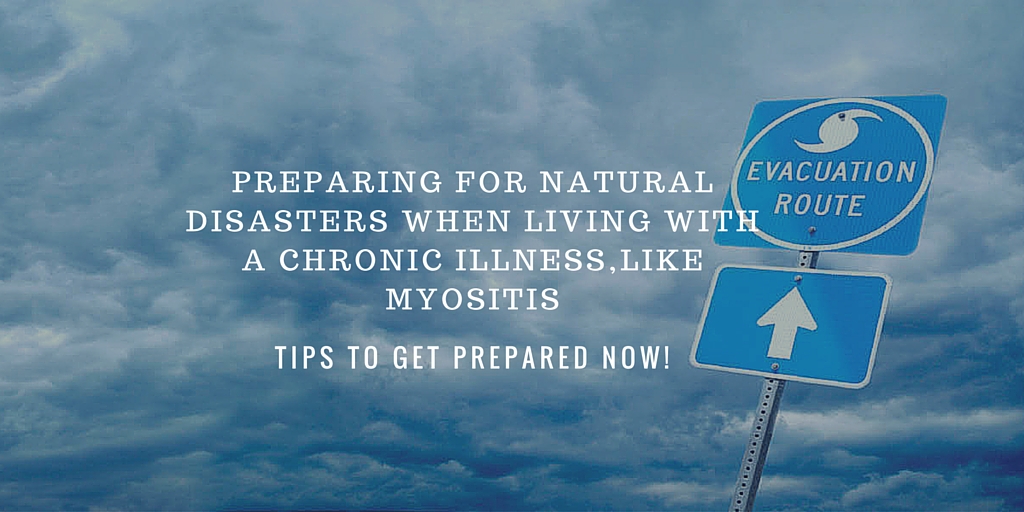Are you prepared for natural disasters?
Myositis patients have special needs that require planning
 Let’s face it, having any form of Myositis can be dangerous when an emergency such as a hurricane, blizzard, wildfire, earthquake or flood happens. Our disease often makes us weak, fatigued, in pain, and sometimes unable to think clearly due to brain fog. Some of us are unable to walk without an assistive device such as a cane or walker, while others are in wheelchairs or power chairs. Some are on oxygen for lung disease caused by Myositis while others may be on insulin, Achtar/Methotrexate injections, or many other medications that might be taken to manage our illness. So how do we, those living with a chronic autoimmune disease that limits our mobility, truly prepare, plan, and evacuate in the time of an emergency or disaster?
Let’s face it, having any form of Myositis can be dangerous when an emergency such as a hurricane, blizzard, wildfire, earthquake or flood happens. Our disease often makes us weak, fatigued, in pain, and sometimes unable to think clearly due to brain fog. Some of us are unable to walk without an assistive device such as a cane or walker, while others are in wheelchairs or power chairs. Some are on oxygen for lung disease caused by Myositis while others may be on insulin, Achtar/Methotrexate injections, or many other medications that might be taken to manage our illness. So how do we, those living with a chronic autoimmune disease that limits our mobility, truly prepare, plan, and evacuate in the time of an emergency or disaster?
A good first step is to get on a registry if one exists in your location. Some local emergency management offices maintain registries for people with disabilities. Some registries are only used to collect planning information while others may be used to offer assistance in emergencies. If you add your name and information to a registry, be sure you understand what to expect. Be aware that a registry is NEVER a substitute for personal preparedness. Even if the registry may be linked to first responders, assistance may not be available for hours, or days in a true disaster. Contact your local emergency management agency to see if these services exist in your area, or visit www.ready.gov to find links to government offices near you.
Another important consideration is wearing medical alert tags or bracelets that identify your access and functional needs. This can be a crucial aid in an emergency situation. Also, consider printing and laminating the Functional Abilities document so that others are informed on what you can and cannot do. You can download the Functional Abilities document here.
If you are injured and end up in the hospital, you may run into doctors who are not familiar with Myositis. You can print our types of myositis information sheets that provide information about each form (see links at the end of this article), as well as our Medications Form so you do not have to try and remember your medications. Some of the medications we take are important to note, such as prednisone. If you are injured, the doctors may need to provide you with extra dosing of steroids.
We can plan ahead!
Planning is the key to being prepared during an emergency or disaster. Create a kit that contains the most important things you may need whether you are evacuated or plan to stay home during a storm or other natural disaster. Below are some key things to consider including and some things to think about:
- Battery chargers for motorized wheelchairs or other battery-operated medical or assistive technology devices.
- If you use a motorized wheelchair, have a lightweight manual chair available for emergencies.
- If you are on oxygen, if possible, have extra portable tanks for emergencies and power outages.
- If possible, include extra insulin, catheters, or other medical supplies you use regularly.
- If you have a communication disability, make sure your emergency information includes instructions for the best way to communicate with you, such as writing, and/or a cell phone with text talking ability.
- Copies of medical prescriptions, doctors orders, and the style and serial numbers of the support devices you use.
- Written descriptions of your disability and support needs, in case you are unable to describe the situation in an emergency. Download the Functional Abilities form.
- Medical insurance cards, Medicare/Medicaid cards, physician contact information, a list of your allergies, and a health history.
- A list of the local nonprofit or community-based organizations that assist people with access and functional needs similar to yours.
- Consider putting important information onto a portable thumb drive/flash drive for easy transport in an evacuation.
- Fill your car with gasoline before a storm hits.
- Have cash on hand!
Include Emergency Documents
Include copies of important documents in your preparations such as insurances (life, home, auto, flood), family records, medical records, wills, deeds, social security number, charge and bank accounts information, and tax records. It is best to keep these documents in a waterproof container. If there is any information related to operating equipment or life-saving devices that you rely on, include those as well. Make sure that a trusted friend or family member has a copy of these documents. Include the names and numbers of everyone in your personal support network, as well as your medical and disability service providers.
Include Medications and Medical Supplies
Many of us take medications or natural health products to manage our disease or use medical supplies on a daily basis. Be sure you have what you need on hand to make it on your own for at least a week. You should also keep a copy of your prescriptions, as well as dosage or treatment information. If it is not possible to have a week-long supply of medicines and supplies, keep as much as possible on hand and talk to your pharmacist or doctor about what else you should do to prepare. If you undergo routine treatments administered by a clinic or hospital, or if you receive regular services at home such as home health care, meals, oxygen, or door-to-door transportation, talk to your service providers about their emergency plans. Work with them to identify backup service providers within your area and the areas you might evacuate to. If you use medical equipment in your home that requires electricity to operate, talk to your healthcare provider about what you can do to prepare for its use during a power outage.
Create a Personal Support Network
If you anticipate needing assistance during a disaster, make a list of family members and friends who will be part of your plan. Talk to these people and ask them to be part of your support network. Share each aspect of your emergency plan with everyone in your group, including a friend or relative in another area who would not be impacted by the same emergency, who can help if necessary. Make sure everyone knows how you plan to evacuate and where you will go in case of a disaster. Make sure that someone in your personal support network has an extra key to your home and knows where you keep your emergency supplies. Teach them how to use any lifesaving equipment or administer medications in case of an emergency. If you use a wheelchair, oxygen, or other medical equipment, show friends how to use these devices so they can move you if necessary, or help you evacuate. Practice your plan with those who have agreed to be part of your personal support network.
Prepare for an emergency at work
If you are employed, inform your employer and co-workers about the assistance you will need in an emergency. This is particularly important if you need to be lifted or carried. Talk about communication difficulties, physical limitations, equipment instructions, and medication procedures. If you are deaf or hard of hearing, discuss the best ways to alert you in an emergency. If you have a cognitive disability, be sure to work with your employer to determine how to best notify you of an emergency and what instruction methods are easiest for you to follow.
What about your pets or service animals?
Whether you decide to stay put in an emergency or evacuate to a safer location, you will need to make plans in advance for your service animals and pets. Keep in mind that what’s best for you is typically what’s best for your animals. If you must evacuate, take your pets with you. However, if you are going to a public shelter, it is important to understand that by law only service animals must be allowed inside. However, there are many shelters that will allow pets if they are in a crate or carrier, but don’t count on that. Contact them just in case.
Know a Safe Place to Take Your Pets
Plan in advance for shelter alternatives that will work for both you and your animals.
According to the Red Cross, local and state health and safety regulations do not permit the Red Cross to allow pets in disaster shelters. (Service animals are allowed in Red Cross shelters.)
Some places that may help your pets
- Contact hotels and motels outside your local area to check their policies on accepting pets and restrictions on number, size, and species. Ask if “no pet” policies can be waived in an emergency. Keep a list of “pet-friendly” places, including phone numbers, with your disaster supplies.
- Ask friends, relatives, or others outside the affected area whether they could shelter your animals.
- Make a list of boarding facilities and veterinarians who could shelter animals in an emergency; include 24-hour phone numbers.
- Ask local animal shelters if they provide emergency shelter or foster care for pets during a disaster.
Prepare your pet’s emergency materials as well
Keep your pet’s essential supplies in sturdy containers that can be easily accessed and carried (a duffle bag or covered trash containers, for example). Planning for your pet or service animal should include:
- Pet medications and medical records (stored in a waterproof container) and a First Aid kit.
- Sturdy leashes, harnesses, and/or carriers to transport pets safely and ensure that your animals can’t escape.
- Current photos of your pets in case they get lost.
- Food, water, bowls, cat litter/pan, and a manual can opener.
- Information on feeding schedules, medical conditions, behavior problems, and the name and number of your veterinarian in case you have to foster or board your pets.
- Your pets favorite toy and a blanket to help keep them calm during an emergency.
Help Emergency Workers Help Your Pets
The ASPCA recommends using a rescue sticker alert to let people know that pets are inside your home. Make sure it is visible to rescue workers and that it includes the types and number of pets in your household. Make sure to also include your veterinarian’s phone number.
If you must evacuate with your pets (and if time allows) write “EVACUATED” across the stickers so rescue workers don’t waste time looking for them.
While many of us with autoimmune diseases such as Myositis need to focus on creating a plan that will involve physical help transporting us to safety, having a team of friends and relatives on board is essential.
With proper planning, you, your service animal, your pets, and your family/support network can be properly prepared if asked to evacuate. These ideas can help ensure that all of your materials and belongings are safe and put together beforehand so you do not have to stress at the last minute.
Download and print myositis information sheets:
Inflammatory Myopathy Overview
Necrotizing Autoimmune Myopathy










